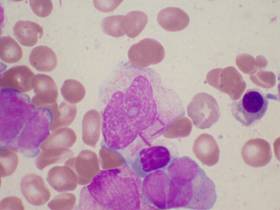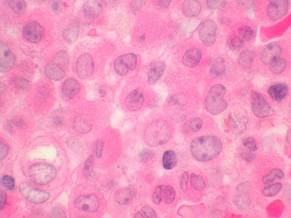Distinct entity which is characterized by:
- Arrested maturation of leukemic cells at the promyelocytic stage.
- Presence of the PML-RAR alpha fusion protein - results from t(15;17) translocation
- Hemorrhagic diathesis and coagulopathy
- Responsive to all trans retinoic acid (ATRA) and anthracyclines.
First type of leukemia treated successfully with targeted therapy. ATRA binds to the PML-RAR alpha fusion protein and induces differentiation of the blasts to mature granulocytes.
APL accounts for less than 10% of all cases of AML.
Most cases of APL are classified as M3 in FAB system. - appearance of blasts reflects the arrest in promyelocytic phase of myeloid differentiation.
Leukemic promyelocytes have:
- Reniform or bilobed nucleus
- Large azurophilic granules
- Auer rods
Bone Marrow Aspirate in APL:

In acute promyelocytic leukemia, the bone marrow aspirate is:
- Particulate and cellular
- Granulopoiesis is left-shifted
- Promyelocytes consist of about 24% of total bone marrow cells
- Approximately 20% blasts are present
- These blasts and promyelocytes are:
- Medium in size
- Low nuclear to cytoplasmic ratio
- Fine chromatin
- One to two prominent nucleoli.
- A few blasts contain convoluted nuclei
- There is variable cytoplasmic granularity. Rare Auer rods are seen, including very rare cells with multiple Auer rods. These results suggest a diagnosis of acute promyelocytic leukemia.
Bone Marrow Biopsy in APL:

The bone marrow shows:
- Increased cellularity (90-95%).
- Megakaryocytes appear slightly decreased in number but normal in morphology (not seen in the image provided).
- Erythropoiesis appears decreased.
- The majority of cells present (more than 80%) consist of blasts and immature granulocytes.
- Increased mitotic figures are usually seen (not shown in the image provided).
Cytogenetics:
- Most commonly see t(15;17)(q22;q12)
- Also see t(11;17) (fuses PLZF gene to RARA gene) – this type of APL not sensitive to ATRA therapy
For description of cytogenetics
Atlas of Genetics and Cytogenetics in Oncology and Haematology
Acute promyelocytic leukemia at Humpath.com
Therapy:
APL leukemic cells are sensitive to all-trans retinoic acid (ATRA)
ATRA:
- Induces differentiation
- Overcomes repression of signaling caused by the PML/RARA fusion protein at physiologic concentrations
- Restores signaling leading to differentiation of APL cells and then postmaturation apoptosis
Most patients with APL achieve a complete remission (CR) when treated with ATRA.
Single-agent ATRA generally not curative.
Series of randomized clinical trials have shown the benefit of combining ATRA with chemotherapy during induction therapy and ATRA can be used as maintenance therapy.
Survival rates over 80% using treatment regimes that include ATRA
Therapy for relapse includes arsenic trioxide
External Links:
Acute Promyelocytic Leukemia Therapy at the National cancer Institute

